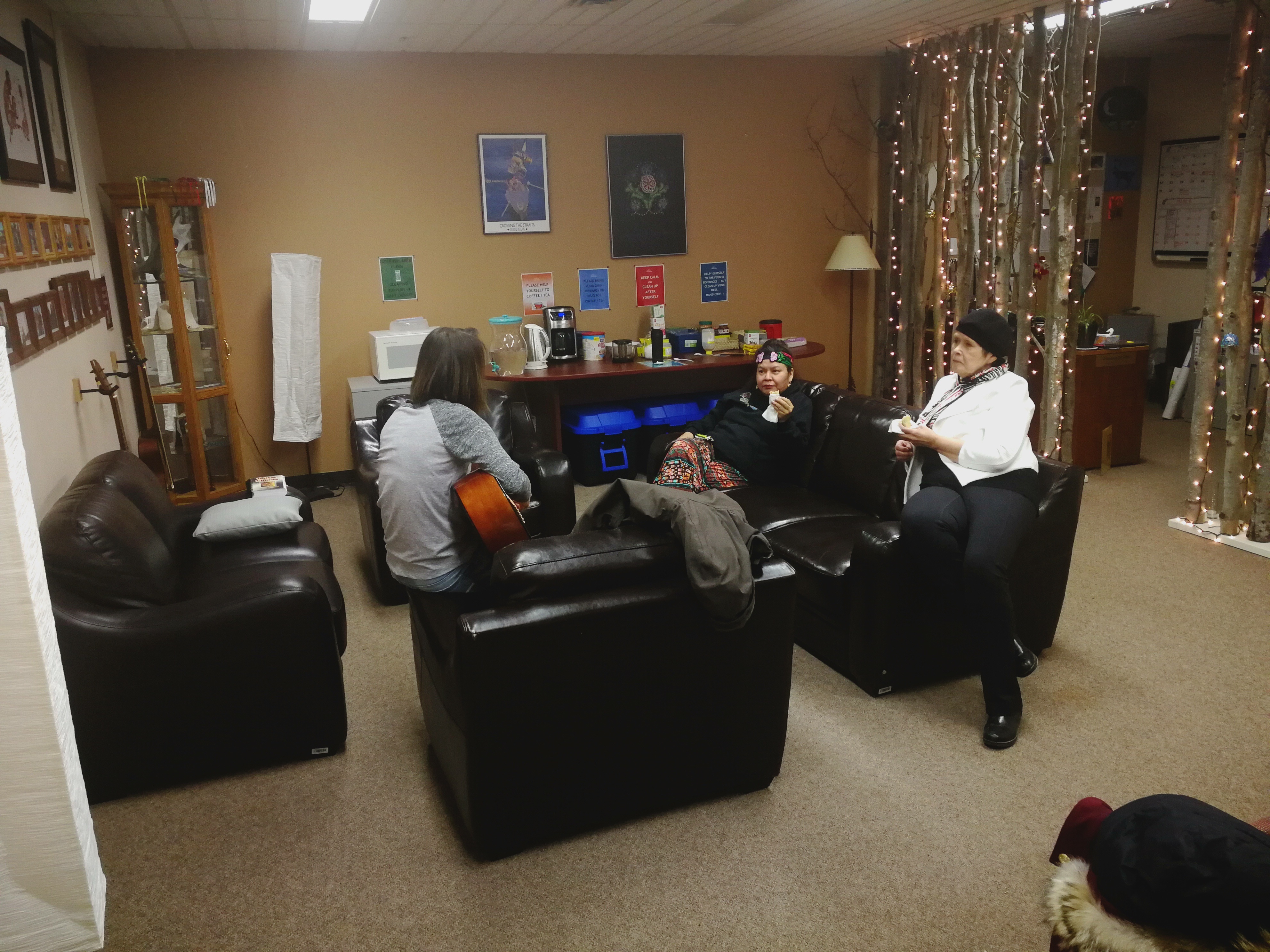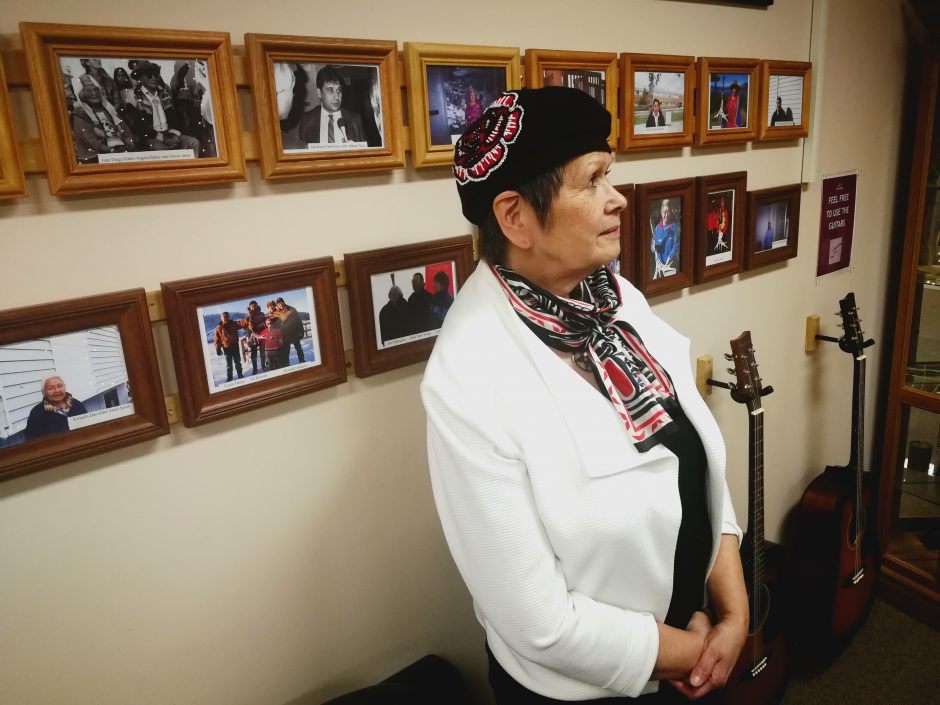March 19, 2018
Charlene Baker sits at a round table in the Harry Allen lounge, down the hall from the main entrance to the Ayamdigut Campus of Yukon College, in Whitehorse.
Laid out in front of her are trays of beads, half-finished slippers, and pieces of tanned moose hide. The middle finger on her right hand is protected by a piece of tanned hide and she’s using a needle and thread to add purple beads to a flower design.
Baker is explaining to another student, Kelly Tobalt, that you have to be relaxed before you start beading.
“Take care of everything that bothers you, so you don’t bead your problems into your work,” Baker says.
Baker is a student in the Yukon Native Teacher Education Program. The slippers she’s making are for her son. She has other projects on the go, too — they are strewn out in front of her on the table.


Tobalt grew up in Quebec but for the last five years she has lived and travelled in countries around the world. She is studying for her third degree and decided to come to Yukon College because it offers exposure to different cultures.
“We have amazing rich culture in Canada, I really don’t know much about, because it’s not something that is prevalently taught,” says Tobalt.
Tobalt learned to bead in Kenya; she came to the Heen Club to learn about different styles of beading in Yukon First Nations cultures.
Baker started the Heen Club — a sewing, beading and weaving club — partly as a way to set aside time for all her projects.
‘Heen’ is Tlingit for ‘water.’ Baker gave the club that name because, she says, “When you’re listening to your elders, we are taught to drink water to retain knowledge.”
'It’s like gems in a mine.'
Shirley Adamson is sitting at the table, too, listening to Tobalt describe the colours and patterns she saw in Kenya.
Adamson works at the college; she’s one of four Elders on Campus.
It’s lucky to have more than one generation in a room, that’s what Baker says. That’s part of the reason that she asked Adamson to be the elder of the Heen Club.
“It’s like gems in a mine. You just go in there and admire, you’re just blown away. That’s how I feel in the presence of Shirley Adamson,” said Baker.

The presence of elders on campus isn’t new.
The college has been trying to integrate indigenous knowledge and ways of knowing into its culture for at least 10 years. That’s how long ago Tosh Southwick was hired as the executive director of First Nation Initiatives and Community Engagement.
These days, spurred by the Truth and Reconciliation Commission’s 94 Calls to Action, Southwick finds herself responding to requests from other education institutes across the country, wanting to learn from the college about its indigenization efforts.
The TRC’s calls to action in education urge the development of culturally appropriate curricula, the teaching of Aboriginal languages as credit courses, respecting and honouring treaty relationships and improving education attainment levels and success rates for Indigenous students.
Southwick said the release of the calls to action at the end of 2015 validated the work the college is doing. Now, she says she asks herself, “How are we going to do this better, and how are we going to lead the way, and how are we going to share our story?”
Debra-Leigh Reti, who co-ordinates the Elders on Campus program, said she approached Adamson a few years ago after she gave a lecture on land claims, and asked if she’d consider the position.
Adamson said she had never thought of herself as an elder.
“I’m an older woman, but you know being an elder is a huge honour in traditional way and certainly in First Nations culture.”
She thought hard about Reti’s proposition, and said she has an obligation to pass on the knowledge that was handed down to her. It didn’t take her long to decide to take up the position.
“I don’t think we have the benefit of time, really,” said Adamson.
There’s a huge danger of knowledge being lost if it’s not being shared, especially in language, she said.


Eventually, everyone makes their way to the Harry Allen lounge. That’s what Adamson has noticed.
“We’ve got tea, we bring in our snacks, there’s always an elder here. We’ve got guitars here,” said Adamson.
The lounge is named after the late Harry Allen, a contemporary of Adamson, a pioneer in creating land claims agreements for the Yukon, and a grand chief of the Council of Yukon First Nations.
“The college has really worked towards incorporating First Nation culture into the culture of the college,” said Adamson.
- First made-in-Yukon college degree focuses on Indigenous governance
- Yukon College, First Nations develop online course, First Nations 101
Reti joins Adamson at the round table, they both have their day planners out. They are co-ordinating a time and room for Adamson to teach weekly casual Southern Tutchone language lessons.
“It’s going to be fun,” Adamson said. “It’s just to give people very basic phrases so that they can practise that.
“You’ll be able to introduce yourself, lay down your credentials, order a double-double if you want.”
Along with giving language lessons, lecturing and being the elder of the Heen club, Adamson’s mere presence on campus helps students feel at home.
'Sometimes you just get homesick.'
“Sometimes they just want to be in the presence of an elder,” she said.
“Sometimes you just get homesick.”
There are three other elders on the campus.
“Each of us bring our own experiences, our own teachings, our own life experiences, because we all have our own teachings,” said Adamson.
“I think it’s very important that we share that traditional knowledge. Because to be aboriginal here on the lands of our grandmothers validates that our identity does not come from the Indian Act.”
The elders don’t only benefit the students. Reti said she noticed that her work habits changed after she started co-ordinating Elders on Campus.
“My working style, is, like, bam! bam! bam! Get things done,” she said.
The elders slowed her down, told her to take her time. They taught her to sit and listen, not to talk over people.
“Sometimes we run into some bumps in the road, we’ve got to deal with this issue or that issue,” said Reti.
Now she asks the elders for advice.
“They teach you how to deal with things. They’ve experienced it already,” she said.
Reti calls it “real learning,” and says it reminds her of who she is.
“Because I didn’t grow up in my traditional Vuntut Gwitchin culture. So I learned a lot from the elders.”
Elder input into new lounge
The college has a new study lounge called the Innovation Commons. It opened in December. There was a ceremony which Shirley Adamson opened and closed with a prayer in Southern Tutchone.
Adamson loves the new study lounge. She says it makes her feel like Joan Jetson because it’s so modern.
But the college consulted with elders on the design — old knowledge is worked into the new, modern room. Elders asked designers to make the furniture circular, to have open spaces with natural light, to have colours that represent the seasons and windows that look out onto the mountains.
Southwick points to the Innovation Commons as an example of reconciliation.
“It shows that it’s a safe space where your culture is valued, and that it’s OK to think that education might look a little different, or that space can look a little different,” she said.
'It’s OK to think that education might look a little different.'
Conversations that Southwick has with students and colleagues also shows her how far the college has come in its efforts to give everyone a baseline of knowledge about First Nations and land claims agreements history.
“Now we’re talking about some of the hard things like the legacy of residential school, like the over-representation in jails,” she said.
Back at the round table in the Harry Allen lounge, Charlene Baker calmly sews beads onto leather as she explains how she’s going to integrate pattern making and math required for beading into her math lessons as a teacher.
“I want to have my culture on my right hand and my education on my left hand. This is what was taught to me by my mother,” she said.
This story is part of our project Beyond 94: Truth and Reconciliation in Canada. Read more stories in the series and look for further coverage this week.
